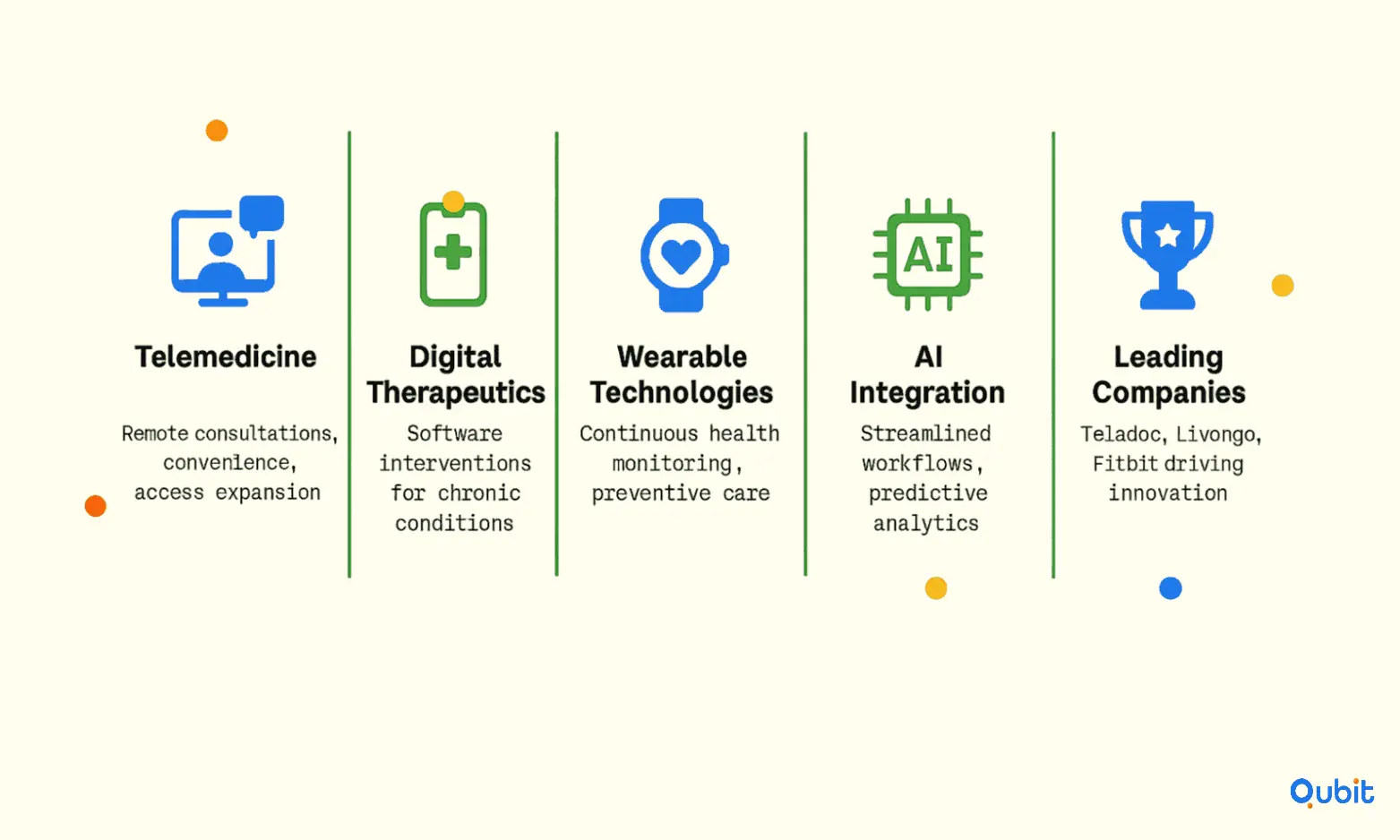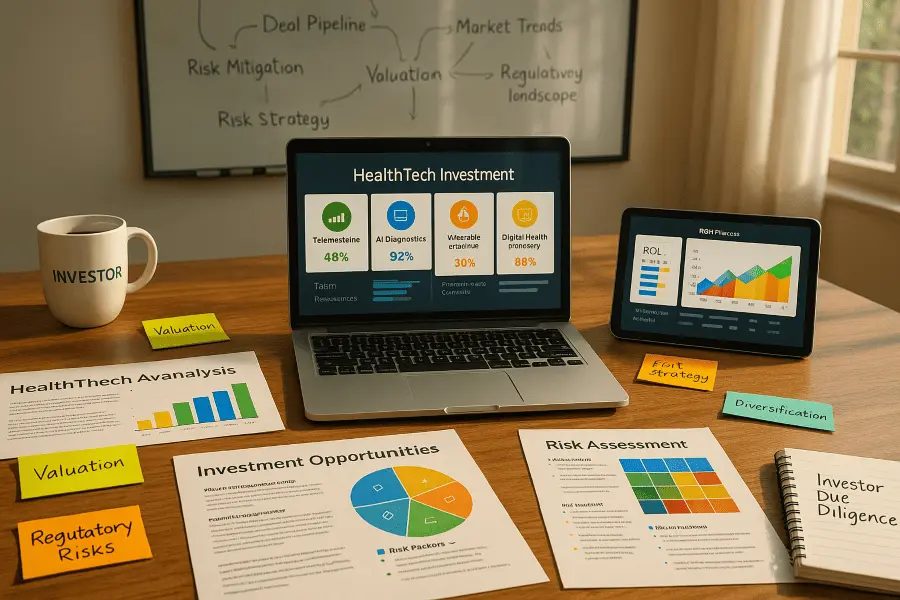The healthtech industry is reshaping the future of healthcare, offering innovative solutions that merge technology with patient care. For investors, this sector presents a unique opportunity to support groundbreaking advancements while achieving significant returns. With the global healthtech market projected to grow exponentially, understanding how to approach healthtech investment is crucial.
From digital health platforms to AI-driven diagnostics, the industry is brimming with potential. Early-stage funding strategies, such as crowdfunding healthtech startups, represent a community-oriented approach that can complement traditional investment methods. This dynamic sector thrives on innovation, making it essential to grasp the market drivers, assess risks, and explore diverse investment avenues.
This blog will demystify the process of investing in healthtech, offering actionable strategies and insights. Let’s jump right in.
Key Drivers and Rationale Behind HealthTech Investments
The healthtech sector is witnessing a surge in investments, fueled by transformative trends and evolving healthcare demands. From the rapid adoption of digital technologies to government-backed initiatives, several factors are reshaping the industry and creating lucrative opportunities for stakeholders.
The Role of Digital Transformation
Digital transformation in healthcare is revolutionizing how care is delivered and managed. Technologies like electronic health records (EHRs), telemedicine platforms, and AI-powered tools are streamlining operations and enhancing patient outcomes. For example, EHRs enhance care coordination, enabling integrated care across multiple providers while reducing errors and duplicative testing. This shift toward digitized workflows not only improves efficiency but also attracts investors eager to capitalize on scalable solutions.
COVID-19: A Catalyst for Innovation
The pandemic accelerated the adoption of telehealth and other digital health solutions, transforming them from optional services to essential components of care delivery. Telemedicine usage skyrocketed as patients sought safe, remote alternatives to in-person consultations. This rapid uptake spurred innovation in areas like virtual diagnostics, wearable health devices, and AI-driven triage systems, making healthtech investment a priority for those aiming to meet the growing demand for accessible healthcare.
Transition to Value-Based Care
Healthcare systems worldwide are moving away from fee-for-service models toward value-based care, emphasizing quality and outcomes over volume. This shift is driving interest in predictive analytics and operational tools that help providers optimize care delivery while reducing costs. By focusing on patient-centric solutions, healthtech companies are aligning their offerings with the evolving priorities of healthcare organizations, further strengthening their investment rationale.
Supportive Government Policies
Proactive government initiatives are lowering entry barriers for healthtech startups and fostering market growth. Policies promoting interoperability, data security, and telehealth reimbursement are encouraging innovation and adoption. These measures not only create a favorable environment for healthtech companies but also reassure investors about the long-term viability of their investments in the sector.
Other Growth Catalysts
Beyond the major drivers, factors like demographic shifts, rising healthcare costs, and increasing consumer demand for personalized care are contributing to the healthtech boom. Aging populations and chronic disease prevalence are pushing healthcare systems to adopt technology-driven solutions, while consumers are embracing tools that empower them to take control of their health.
The convergence of these elements underscores why healthtech investment is becoming a cornerstone of modern healthcare strategies. As the industry continues to evolve, the opportunities for innovation and growth remain boundless.
Current Market Dynamics and Investment Opportunities in HealthTech
The healthtech industry is undergoing a transformative phase, with projections indicating exponential growth over the next decade. According to Allied Market Research, the global healthtech market is forecasted to exceed $3 trillion by 2033, growing from $908.5 billion in 2023 at a compound annual growth rate (CAGR) of 13.1%. This remarkable expansion underscores the sector’s potential to redefine healthcare delivery and innovation, making it a prime focus for investors.
Key Areas Driving HealthTech Investment
Several sub-sectors within healthtech are attracting significant attention due to their scalability and impact on healthcare systems.

Telemedicine
Telemedicine has emerged as a cornerstone of modern healthcare, enabling remote consultations and reducing barriers to access. The demand for telemedicine solutions surged during the pandemic and continues to grow as patients and providers prioritize convenience and efficiency. Companies specializing in telehealth platforms are receiving substantial funding, reflecting their critical role in reshaping patient care.Digital Therapeutics
Digital therapeutics leverage software-based interventions to treat or manage medical conditions. These solutions are particularly impactful in chronic disease management, offering personalized care plans and real-time monitoring. Investors are drawn to this space due to its ability to complement traditional treatments while reducing healthcare costs.Wearable Technologies
Wearable devices, such as fitness trackers and smartwatches, are revolutionizing preventive care by providing continuous health monitoring. These technologies empower individuals to take charge of their health while offering valuable data to healthcare providers. The intersection of wearables and artificial intelligence is further enhancing their utility, making them a lucrative investment avenue
Spotlight on Key Players
The healthtech market is populated by established giants and innovative startups, each contributing to the sector’s growth. Companies like Teladoc Health, Livongo, and Fitbit are leading the charge in telemedicine, digital therapeutics, and wearables, respectively. Meanwhile, emerging players are introducing disruptive technologies that challenge traditional healthcare models.
For investors seeking early-stage opportunities, a review of angel investment healthtech highlights how private investors contribute nuanced perspectives that align with your venture’s early financial structure. Understanding the expectations and processes around angel funding can be pivotal for navigating this dynamic market.
Risks to Consider
While the healthtech sector offers immense potential, it is not without challenges. Regulatory hurdles, data privacy concerns, and the need for interoperability between systems can pose significant risks. Additionally, market saturation in certain sub-sectors may limit growth opportunities for new entrants. Investors must conduct thorough due diligence to identify sustainable ventures and mitigate these risks effectively.
The healthtech market is a dynamic and rapidly evolving space, offering unparalleled opportunities for those willing to embrace its complexities. By focusing on high-growth areas like telemedicine, digital therapeutics, and wearables, and understanding the inherent risks, investors can position themselves to capitalize on this transformative industry.
Executing Innovation: Strategies for HealthTech Investments
Refining Technology for Market Success
Achieving success in healthtech investments begins with refining technology to meet market demands. Timely product development, paired with iterative improvements, ensures alignment with user needs and maintains a competitive edge. For instance, platforms like YouCOMM demonstrate how targeted tools can speed up healthtech adoption. By facilitating direct communication between hospital patients and medical staff, this solution highlights the importance of real-time communication in improving patient satisfaction.
Iterative refinement also allows healthtech companies to adapt to shifting industry standards. Regular feedback loops, combined with agile development processes, help identify gaps and optimize functionality. This approach not only enhances usability but also builds trust among end-users, such as healthcare providers and patients.
Accelerating Growth Through Strategic Partnerships
Collaborations are pivotal in scaling healthtech ventures. Joint ventures and mergers & acquisitions (M&A) offer opportunities to pool resources, expand market reach, and drive innovation. Strategic partnerships can fast-track access to cutting-edge technologies and established networks, reducing the time required to achieve growth milestones.
For readers preparing to scale their healthtech venture through more substantial funding rounds, we recommend exploring mid-stage strategies through an examination of series a funding healthtech, which outlines targeted methods for navigating mid-stage investment rounds while addressing your startup's evolving needs.
M&A, in particular, can be transformative. By acquiring complementary technologies or merging with established players, healthtech firms can diversify their offerings and strengthen their market position. However, success in these ventures requires thorough due diligence and a clear alignment of goals between partners.
The Role of Decisive Execution
Decisive execution is the cornerstone of capitalizing on emerging opportunities in the fast-paced healthtech market. Allocating resources effectively and acting swiftly on strategic plans ensures that companies stay ahead of competitors. This involves prioritizing initiatives with the highest potential for impact and maintaining focus on long-term objectives.
In addition, fostering a culture of innovation within the organization can drive decisive action. Teams that are empowered to experiment and take calculated risks often uncover new opportunities for growth. Combining this mindset with robust project management ensures that ideas are translated into tangible results.
Emerging Trends Shaping HealthTech Investments
The healthtech sector is undergoing a transformative shift, driven by groundbreaking technologies and evolving market demands. From AI-powered solutions to the expansion of telehealth, these trends are redefining how healthcare is delivered and managed. Below, we explore the most impactful developments shaping healthtech investment opportunities.
AI-Driven Tech Convergence
Artificial intelligence (AI) is revolutionizing healthcare by streamlining clinical workflows and enhancing diagnostic precision. By integrating AI into clinical settings, healthcare providers can reduce administrative costs by up to 30% while improving diagnostic accuracy. This dual benefit makes AI a strong focus area for healthtech investment moving forward. The convergence of AI with other technologies, such as machine learning and natural language processing, is also enabling predictive analytics, which can anticipate patient needs and optimize treatment plans.
Advancements in Remote Patient Monitoring
Remote patient monitoring (RPM) technologies are becoming indispensable in modern healthcare. These tools allow for continuous tracking of patient health metrics, such as heart rate, glucose levels, and blood pressure, from the comfort of their homes. By enabling early intervention and reducing hospital readmissions, RPM not only improves patient outcomes but also significantly cuts healthcare costs. This trend is particularly appealing to investors, as it aligns with the broader push for value-based care models.
The Telehealth Revolution
Telehealth has emerged as a game-changer, expanding access to care for underserved populations and reducing geographical barriers. A compelling example of this is the Telemedicine Implementation in Rohingya Refugee Camps. In these camps, telehealth services facilitated over 500,000 patient contacts annually, addressing critical physician shortages with the support of international specialists. Such case studies underscore telehealth’s potential to bridge healthcare gaps globally, making it a key area for healthtech investment.
The Critical Importance of Data Security
As digital health solutions proliferate, the need for robust cybersecurity measures has never been greater. Protecting sensitive patient data is not just a regulatory requirement but also a cornerstone of maintaining trust in healthtech innovations. Cybersecurity breaches can have devastating consequences, from financial losses to reputational damage. Therefore, healthtech companies are prioritizing investments in advanced encryption, secure cloud storage, and real-time threat detection systems.
For startups aiming to capitalize on these trends, understanding the healthtech venture capital landscape is crucial. A discussion of healthtech venture capital illustrates how the venture ecosystem adapts to scalability challenges, offering you a clearer view of market-led funding.
Avoid Pitfalls: Risks and Challenges in HealthTech Investments
Healthtech investment offers immense potential, but it’s not without its hurdles. From regulatory complexities to safeguarding sensitive data, investors face a range of challenges that can impact returns. Understanding these risks and adopting proactive strategies is essential for navigating this dynamic sector.
1. Regulatory Compliance: A Constant Balancing Act
The healthtech industry operates under stringent regulations that vary across regions. Compliance with laws such as HIPAA in the U.S. or GDPR in Europe is non-negotiable. Failure to meet these standards can lead to hefty fines, reputational damage, or even the shutdown of operations.
To mitigate this risk, healthtech startups must prioritize legal expertise early on. Engaging regulatory consultants and maintaining transparent communication with legal advisors can help ensure adherence to evolving standards. Additionally, building compliance frameworks into the product development process can prevent costly retrofits later.
2. Data Privacy and Security Concerns
The reliance on patient data in healthtech solutions makes data privacy and security a top priority. Cyberattacks and data breaches not only compromise sensitive information but also erode trust among users. For investors, such incidents can translate into financial losses and long-term reputational harm.
To address this, startups should adopt robust cybersecurity measures, including encryption, multi-factor authentication, and regular security audits. Investors can also evaluate a company’s data protection protocols before committing funds. A strong focus on data security not only minimizes risks but also enhances the startup’s credibility in the market.
3. Fierce Competition in a Rapidly Evolving Market
The healthtech sector is marked by intense competition, with new players entering the market regularly. This saturation can make it difficult for startups to differentiate themselves and achieve sustainable growth. For investors, this means a higher likelihood of backing a company that may struggle to gain traction.
One way to counter this challenge is through innovative funding strategies. An exploration of bootstrapping healthtech startup methods reveals approaches that support self-sufficient growth without relying on external capital. By focusing on financial discipline and minimizing liabilities, startups can build resilience and stand out in a crowded market.
4. Practical Strategies for Risk Mitigation
Investors can safeguard their returns by adopting a proactive approach to risk management. Here are some actionable strategies:
- Due Diligence: Conduct thorough research on the startup’s regulatory compliance, data security measures, and market positioning.
- Diversification: Spread investments across multiple healthtech ventures to reduce exposure to a single point of failure.
- Ongoing Monitoring: Regularly review the startup’s performance and adapt strategies as needed to align with market changes.
By combining these strategies with a keen understanding of the sector’s challenges, investors can position themselves for success in the healthtech landscape.
Conclusion
A well-structured approach to healthtech investment can make all the difference in identifying opportunities with transformative potential. Throughout this blog, we’ve explored key strategies, including the importance of a clear narrative, understanding market dynamics, and aligning investments with long-term healthcare trends. These insights underscore the value of a focused and informed approach to this rapidly evolving sector.
If you’re looking to turn pilots into paid deployments, at Qubit we understand clinical validation, EHR integrations, and security reviews. Move faster with our healthtech fundraising assistance and book a quick strategy call.
Key Takeaways:
- Healthtech investments are fueled by rapid digital transformation and evolving care models.
- The market shows multi-trillion-dollar potential with key opportunities in telemedicine and digital therapeutics.
- Strategic execution—through technology refinement and partnerships—is critical for success.
- Emerging trends like AI integration and remote patient monitoring are reshaping the industry.
- Effective risk management and regulatory compliance are essential to safeguard investments.
Frequently asked Questions
What is healthtech and why is it important?
Healthtech represents the fusion of healthcare and technology, revolutionizing how care is delivered. It enhances patient outcomes, streamlines operations, and supports value-based care models, making it a cornerstone of modern healthcare innovation.






